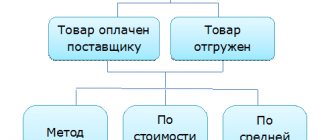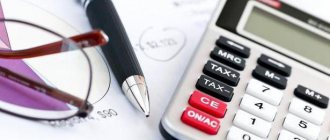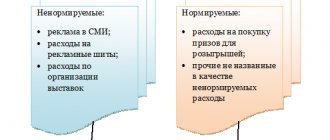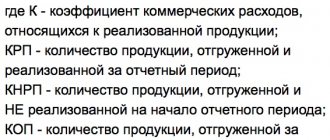In the latest issue of accounting educational program, Alexey Ivanov talks about what revenue, cost, commercial and administrative expenses, other income and expenses are. This classification helps you understand how you make money and what you spend it on. It underlies the grouping of income and expenses in one of the main forms of accounting reporting - the financial performance report. And it helps a lot in management reports.
Hi all! Alexey Ivanov is with you, the knowledge director of the online accounting “My Business” and the author of the telegram channel “Accounting Translator”. Every Friday on our blog on Klerke.ru I talk about accounting. I started with the basics, then I will move on to more complex matters. For those who are just preparing to become an accountant, this will help them get to know the profession better. Seasoned chief accountants should look at familiar categories from a different angle. Last time we figured out the concepts of income and expenses, today I’ll introduce them to their types.
Let's start with income. Income in accounting is divided into revenue and other income.
Revenue
Revenue (Sales Revenue or simply Sales) is income from the company’s normal activities. It is income, not the flow of money. Last time I talked in detail about how these categories differ.
What is considered normal activities is determined by the company itself. The main rule here is systematic income generation. If a product, product, work or service is sold regularly, its sale is a normal activity.
Here's what brings in revenue in different businesses:
- store - sales of purchased goods;
- plant - sales of its own products;
- broker - sales of securities;
- hairdresser - hairdressing services;
- leasing company - renting out property.
In this case, a company may have several normal activities. A grocery store can start producing salads that will be sold along with purchased goods. And the plant sells not only its products, but also purchased spare parts for them. Such sales will also generate revenue.
Once again, I would like to focus on the moment of revenue recognition. Revenue arises in accounting at the moment of transfer of ownership of a product or product from the seller to the buyer. For works and services, the moment of revenue recognition is the date of signing the act of their completion.
The amount of revenue is equal to the amount of the buyer's receivables arising. If the purchase is paid for at the time of purchase, the proceeds coincide with the amount of cash received. If the purchase is partially paid, the proceeds consist of the payment amount and the balance of receivables. This is the so-called “dirty” revenue or gross revenue. It may contain VAT and excise taxes, which will need to be returned to the state. The financial statements reflect net revenue from which these taxes are excluded so that the real income of the company can be understood.
Example 1. A car dealership sold a new Gelendvagen for 12 million rubles. According to the terms of the contract, the client pays half of the cost immediately, and the second half within a year from the date of purchase. Gross revenue consists of 6 million rubles. paid money and 6 million rubles. debtors. Net revenue - 10 million rubles. The remaining 2 million rubles. VAT is the income of the state, not the car dealership.
Direct and indirect costs
Classification of costs according to the method of their inclusion in the cost of products, works and services into direct and indirect. It is this classification that determines the order in which costs are reflected in certain synthetic accounts, subaccounts and analytical accounts.
Direct costs are those that can be directly, directly and economically attributed to a specific type of product or to a specific batch of products (work performed or services provided). In practice, this category includes:
- direct materials costs (that is, raw materials and basic materials used in the production of products);
- direct labor costs (payment of personnel involved in the production of specific types of products).
However, if an enterprise produces only one type of product or provides only one type of service, all production costs will automatically be direct.
Indirect costs are those that cannot be directly, directly and economically attributed to a specific product, so they should first be collected separately (on a separate account), and then - at the end of the month - distributed by type of product (work performed, services provided) based on the chosen techniques.
Among production costs, indirect costs include auxiliary materials and components, expenses for wages of auxiliary workers, adjusters, repairmen, vacation pay, extra pay for overtime, payment for downtime, costs for maintaining workshop equipment and buildings, property insurance, etc. d.
Let us emphasize that indirect costs are associated simultaneously with the manufacture of several types of products, and they either cannot be “attributed” to a specific type of product, or in principle this is possible, but it is impractical due to the insignificance of the amount of this type of costs and the difficulty of accurately determining the part of them that accounts for for each type of product.
In practice, the separation of direct and indirect costs is very important for organizing the work of accounting in terms of cost accounting. Direct costs should be based on primary documents plus possibly additional calculations, as, for example, if the same type of raw material is used to produce several types of products in one division and it is impossible to provide accurate primary accounting of exactly how much of this raw material is spent on each from types of products, be included directly in the cost price of each type of product, formed by the debit of account 20 “Main production”. But indirect costs are collected on separate accounts - for example, shop expenses during the month are debited to account 25 “General production expenses”.
If we talk about the relationship between the two classifications considered, we can note the following:
- all direct costs are basic (after all, they are necessary for the production of specific types of products);
- overhead costs are always indirect;
- Some types of basic expenses, from the point of view of the order of their inclusion in the cost price, are not direct, but indirect - such as, for example, the amount of depreciation of fixed assets used in the production of several types of products.
Other income
Other Revenue is any company income other than revenue:
- rent (for the lessor);
- dividends;
- income from the sale of fixed assets;
- interest on deposits;
- present.
The moment of recognition and measurement of the amount of other income are determined in the same way as for revenue. The exception is gifts. There is no receivable due to a gift, so income is determined based on the market value of the gifted asset.
The division of income into revenue and other income depends on what the company does. For a store, rent is other income, and for a leasing company, it is revenue. The accrued dividends will be revenue for the qualified investor, but other income for the plant. And only gifts qualify as income except from a professional kept woman.
Cost price
Let's move on to the classification of expenses. The first type of expense is cost (Cost of Goods) . These are the costs of manufacturing and selling products, performing work, and providing services. Next I will talk about products, meaning work and services too.
It seems like a simple definition, but it is important to understand that the cost varies. Each of the calculated costs is analyzed for its own purposes. And, if the cost of production is 100 rubles, and the sales revenue is 150 rubles, the profit from sales is not necessarily 50 rubles. Such information is not enough - you need to clarify exactly what cost we are talking about.
Manufacturing cost is the cost of making a product. It needs to be counted and broken down into components in order to understand what can be tweaked in the production process. Reduce waste of materials, switch to cheaper analogues, organize work more efficiently to reduce labor costs, etc.
The monthly production cost shows how much it cost to produce. But it is useless to compare it with revenue for three reasons.
- It is not enough to produce products, they must also be sold. And before it sells, store it somewhere. And all these are additional expenses that affect the financial result.
- Products that were started to be produced this month are not always released in the same month. The costs are already there, but there are no products yet. Such costs in accounting are called work in progress. And this is your asset.
- Products produced in a month are not always sold in the same month. This applies only to products; it is not relevant for works and services. If the products remain in stock, this is your asset.
When you look at the income statement, what you see is the manufacturing cost of goods sold. If you have a trading organization, everything is simpler. Instead of manufacturing cost, there is the cost at which you purchased the resold goods. In accounting, it is called the actual cost of goods.
Cost of sales (full cost) is the cost of manufacturing and selling products. Cost of sales consists of the production cost of products sold and the costs of selling them. It is this cost that must be compared with revenue to correctly determine the financial result.
Example 2. Horns and Hooves LLC produces cakes. During the day, 3 cakes were made and sold. To prepare them, food was purchased for 500 rubles, another 1000 rubles. was the pastry chef's salary. Cakes are sold on Instagram for 1000 rubles. The advertisement cost 2,000 rubles.
Production cost: 1500 rub. (500 rub. + 1000 rub.).
Cost of sales: 3500 rub. (1500 rub. + 2000 rub.).
Sales loss: 500 rub. (3000 rub. - 3500 rub.).
If the owner, when determining the financial result, was guided by production costs, he would decide that he owns a profitable business. But that's not true.
Example 3. Same conditions, but 2 cakes sold.
Production cost of production: 1500 rubles.
Cost of sales: 3000 rub. (2 * 500 rub. + 2000 rub.)
Sales loss: 1000 rub. (2000 rub. - 3000 rub.)
Another 500 rub. — production cost of the cake remaining in the warehouse. If tomorrow they buy it without advertising, then it will bring a profit of 500 rubles.
Classification of expenses in the cost of production by economic content
The most common classification feature that allows you to combine expenses is the grouping of expenses by economic content, which includes the classification of expenses by economic elements and costing items.
Grouping expenses by economic elements involves the allocation of such homogeneous costs that form the cost of all types of goods, works or services produced and which cannot be decomposed into smaller homogeneous elements within the enterprise in question. This division of costs allows you to determine the amount of costs of each type, regardless of their place of origin and direction of use.
The determining factors in the formation of cost elements are the components required in the production process:
- means of labor;
- objects of labor;
- labor resources.
Using these groups of mandatory production conditions allows you to group costs and include in them:
- materials costs;
- labor costs with mandatory contributions to state extra-budgetary funds;
- accrued depreciation of labor assets.
A peculiarity of grouping expenses by economic elements is the fact that expenses are combined based on those spent in the production process as a whole for the organization in the amounts of estimated (planned) and actual expenses, regardless of their place of origin and direction of use.
When forming costs by economic elements, their totality is calculated for the reporting period in production activities, regardless of whether the product has been completed by processing, manufacturing or not, whether the work has been completed, whether the service has been provided or not, where the costs are incurred and what type of product is being manufactured. works, services they are used up. This grouping of expenses is mandatory for maintaining financial accounting, and its data is used to prepare accounting (financial) statements, especially explanations to them, and is intended mainly for external users of reporting information.
The composition of expenses that form the cost of production by economic elements is determined by paragraph 8 of the Accounting Regulations “Expenses of the Organization” PBU 10/99, approved by Order of the Ministry of Finance of Russia dated May 6, 1999 No. 33n, and includes the following types:
- material costs;
- labor costs;
- contributions for social needs;
- depreciation;
- other expenses.
Let us consider the content of each economic element that makes up the cost of products, works, and services.
The element “Material costs” combines the cost of:
- purchased raw materials and materials used for production, management and economic needs, components and semi-finished products intended in the organization for installation or additional processing;
- natural raw materials - payment for land reclamation work, payment for water taken from water management systems, etc.;
- fuel purchased externally to be used for technological purposes, expenses for own energy production used for technological needs and for space heating, etc.;
- purchased energy of all types, intended for technological, managerial and economic purposes, etc.
The cost of material resources included in material expenses is calculated in the amount of actual expenses for their acquisition, which includes amounts paid under contracts to the supplier, the cost of consulting, information services for the acquisition of inventories, customs duties, remunerations to intermediary organizations for the acquisition of inventories and etc.
When calculating the cost of actually consumed material assets, the cost of returnable waste generated during the production process is also taken into account. They may completely or partially lose their consumer properties. In this regard, they are assessed at the price of possible use. Returnable waste can be used in the main production after additional processing or can be valued and sold at market prices. Returnable waste also includes raw materials that have changed their chemical composition and material assets that have completely or partially lost their consumer properties.
In " Labor Costs"
» includes the costs of remunerating the main industrial production personnel, including bonuses for the results of production activities, incentives accrued to employees in accordance with the conditions accepted in the organization and compensatory payments related to the regime and working conditions, guaranteed by the Labor Code of the Russian Federation.
Also included in this group are expenses associated with the payment of regular and additional vacations to employees, preferential hours in accordance with the norms of the Labor Code of the Russian Federation, etc.
«Contributions for social needs
", this element of the cost contains a set of mandatory deductions according to the norms of tax legislation to the bodies of state social insurance, pension fund, medical insurance from the amount of accrued wages to the employees of the organization, included in the cost, with the exception of expenses for which insurance payments are not accrued.
Article " Depreciation"
» includes the amount of depreciation charges for fixed assets, intangible assets and profitable investments in tangible assets, calculated monthly for non-current assets on the balance sheet of the enterprise.
The amount of depreciation is included in the cost of production based on:
- the amount of depreciation charges determined on the basis of the cost of depreciable assets;
- their useful life;
- the depreciation calculation method adopted in the accounting policy of the organization.
In the group “ Other expenses”
» expenses included: taxes; fees (payments for emissions of harmful substances, etc.); training costs; entertainment expenses; travel expenses; lifting; rent; costs of consulting, information, auditing services, as well as communication services, banks; other similar costs.
Business expenses
Selling Expenses are the costs of selling goods, products, works, and services. The composition of such expenses depends on what the company does.
If a company manufactures products, then selling expenses begin as soon as the products are released. Commercial expenses will include:
- storage of products (rent or depreciation of warehouses, salaries of storekeepers and loaders);
- promoting it to the buyer (marketing and advertising, services of intermediary sellers);
- shipment (packaging, delivery, export customs clearance, insurance en route).
If a company performs work or provides services, then commercial expenses will be mainly those associated with their promotion. There is simply nothing to store and ship.
If a company sells goods, then almost all costs associated with trade are commercial, except for the cost of the goods themselves:
- procurement (remuneration to intermediary suppliers, customs clearance of imports, insurance during transit);
- delivery (of purchased goods to your warehouse/store and sold goods to the buyer);
- salary (from the director to the salesperson - everyone is involved in sales);
- depreciation or rental of buildings, equipment and vehicles;
- marketing and advertising;
- entertainment expenses;
- warranty repair costs;
- any other costs for storage and shipment of goods.
As you can see, the list of commercial expenses for trading organizations is wider than for manufacturing organizations. Therefore, the share in the financial results report is higher. For example, in the financial statements of the Magnitogorsk Iron and Steel Works for 9 months of 2019, commercial expenses amount to 7% of revenue. And in the same reporting X5 Retail Group - 13%.
Administrative expenses
Administrative Expenses are expenses that are not related to the production, storage and marketing of products, but are necessary for the functioning of the organization. They are also called general economic ones.
This includes:
- salaries of managers and other office employees: from accountant to cleaner;
- office maintenance costs: from coffee and cookies to depreciation or rent;
- communication costs: Internet, telephony, postal correspondence;
- costs of assessment, audit and other consulting services;
- transportation costs for office plankton: from maintaining the director’s personal staff to a corporate taxi or travel tickets at the expense of the company;
- entertainment expenses, if it is not possible to correlate them with the sale of specific goods;
- any other expenses not related to the production, storage or sale of products.
The list of administrative expenses for a particular enterprise depends on the specifics of its activities. For example, for most businesses, an accountant’s salary is a general business expense, but in our online accounting “My Business” it is included in the cost of the service. For a call center, the cost of telephony is a production cost, and for a factory it is a general business expense.
As you can see, management expenses are mainly aimed at maintaining administrative and management personnel and office infrastructure. When I started my career at the plant, the shop floor people called such employees parasites. Because they do not produce products and do not sell them. And you need to feed them.
There is some truth to this. Administrative expenses, as a rule, are semi-fixed. That is, they do not depend on output volumes. This means they should be as small as possible. And one interesting fact is connected with this.
In the income statement, administrative expenses can be shown either in cost of sales or as a separate line item. And here are two examples.
- Private Norilsk Nickel.
- State RusHydro.
In the first case, administrative expenses are shown as a separate line. It is immediately clear that for 1 rub. the cost of production accounts for 14 kopecks in administrative expenses. In the second case, management costs are buried in the cost price. Why it is so big is unclear. Maybe the resources are expensive, or maybe the directors receive huge salaries.
By the way, the new FSBU “Reserves”, although it will not be released in the form in which the Ministry of Finance should have adopted it, prohibits the inclusion of management expenses in the cost of production. As Peter the Great said: “So that everyone’s stupidity can be seen.”
General production and general business expenses
All production costs are divided into general production and general business expenses; they are recorded in 25 and 26 accounts, respectively. General production expenses include costs associated with the maintenance and management of production, including the costs of main production, auxiliary and servicing.
General production expenses include:
- Salaries of workers who work in production (foremen, technologists, workers, etc.);
- Depreciation deductions;
- Necessary repairs of production equipment;
- Payment for raw materials and supplies used in production;
- Rent for production premises and other rental payments for equipment and machinery;
- Other expenses associated with the operation of fixed assets, such as: costs of fuel, electricity and others;
- Shortages, losses and damage to production property, etc.
Account 25 is active, therefore all savings are debited in correspondence with interacting accounts, such as 70 - when calculating salaries, 10 - when writing off materials from the warehouse, 02 - when calculating depreciation, 69 - when calculating contributions to extra-budgetary funds from salaries and etc.
At the very end of each month, all expenses accumulated on account 25 are written off to the debit of accounts 20 “Main production”, 23 “Auxiliary production”, 29 “Service production and facilities” in the manner established independently by the company and recorded in the accounting policy.
When we talk about general business expenses, they are not related to production; such expenses include the costs of managing enterprises, including salaries of office workers, depreciation and repair of business property, office rent, consulting, legal and other services, related to management. These expenses are accumulated in the debit of account 26 in interaction with accounts reflecting expenses - this is account 02 when calculating depreciation, 10 when writing off materials, 70 when calculating wages.
General business expenses are written off in one of two ways:
1. When using reduced cost at the end of the month from account 26 to subaccount 90.2 “Cost of sales”.
2. When using the full cost price, expenses from account 26 are written off to accounts 20, 23 or 29. The procedure for distributing expenses is fixed in the accounting policy; they can be distributed in proportion to the costs of these productions.
Accounts 25 and 26 are completely closed at the end of the month; they have no balance.
Companies that provide intermediary services (agents, brokers, commission agents) keep all expenses on account 26; no accounting is kept on account 20.







